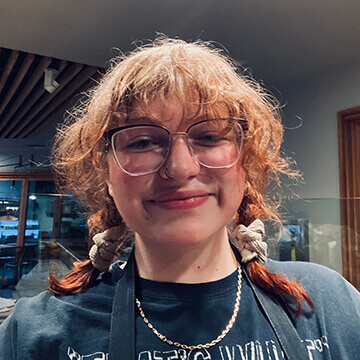Smart high school students know the next step into postsecondary education will require some careful planning. One of the largest pieces of that plan is paying for whatever course of study they’ve decided on.
Just like any other college or technical education, culinary school requires a financial investment. And the cost of school can be a bit shocking to high school students, especially those who haven’t yet been responsible for their own expenses.
But there’s good news! There are many resources out there to help you cover the cost of school. Here are seven ways you may be able to afford culinary school, even if you don’t have a college fund to rely on.
1. Work Part-Time and Save Up During High School
Very few high school students will be able to cover all of their culinary school expenses with what they earn from a part-time job. But even if you’re only able to put away a few thousand dollars, that could put a substantial dent in the amount of money you need to borrow to cover your culinary school tuition and fees.
You may also be able to keep your job during culinary school, continuing to earn an income to pay for some of your education or living expenses. If you do work during culinary school, ask your boss if they’d consider tuition reimbursement. Many employers are eager for more trained kitchen staff, and they may be willing to make an investment in your education to get it!

Working part-time can help high school students earn money for culinary school.
2. Apply for Federal Financial Aid
The most common way that high school students pay for culinary school is through federal financial aid. A combination of student loans and grants, federal aid helps thousands of students to access a culinary education each year.
To find out if you qualify for federal aid, you must fill out the Free Application for Federal Student Aid (FAFSA). The FAFSA is how all students (and their parents) can determine the student’s eligibility for funding including Direct Loans, Parent PLUS Loans, Pell Grants, and federal work-study programs. Even if you think you won’t be eligible for aid, we encourage everyone to start with filling out the FAFSA. You’ll never know what your award package might look like until you apply.
For a step-by-step guide to completing the FAFSA, check out this resource!
A Quick Look at Federal Financial Aid
These are some of the loans and grants that you could be awarded, based on the results of your FAFSA.
- Direct Loans – These are the primary federal loans available to students. These loans are either subsidized, meaning they don’t begin accruing interest until 6 months after the student leaves school or unsubsidized, meaning they begin accruing interest right away.
- Parent PLUS Loans – These loans are awarded to the parents of eligible students. The maximum for a PLUS Loan is the cost of attendance at the student’s school, minus any other financial aid awarded.
- Pell Grants – Pell Grants are awarded based on need, as determined by the FAFSA, and they do not need to be repaid. The maximum Pell Grant award is $6,895 for the 2022-2023 school year.
3. Ask Friends & Family for a Personal Loan
If you have a close friend or family member who may have the financial resources to help you pay for school, you could consider asking them for a personal loan.
The benefit could be a lower interest rate than any bank or lending institution could offer. And your friend or relative may not be concerned with your credit history, the way a lending institution would be. On the other hand, it can be a risky proposition to add a financial element to a personal relationship. Think very carefully (and consult with your parents) before you decide to approach anyone about the possibility of a personal loan. And if you do get one, make sure to have all of the details in writing so the terms of repayment are clear.

Borrowing money from family is an option. Make sure to work through the repayment terms to prevent resentment in the future.
4. Apply for Culinary Scholarships
The best sources of funding for culinary school are the ones that don’t have to be repaid. Yes, we’re talking about scholarships! There are many scholarships available to aspiring culinary school students. And some of those are reserved specifically for graduating high school students.
ProStart®, for example, is a high school culinary program that offers some scholarships to eligible participants. And the National Restaurant Association’s Education Fund awards over $1.2 million in culinary and foodservice scholarships each year, many to graduating seniors. High school students can also participate in cooking competitions for the chance to win scholarship money, like the National ProStart Invitational® and the FCCLA’s Students Taking Action with Recognition (STAR) program.
Your culinary school may offer scholarships directly to students. The Escoffier Scholarship Foundation offers awards to students who demonstrate financial need each year. There may also be scholarships available for the children of active-duty military/veterans.
These applications do take some time to complete. But they can be a valuable source of funding. Some students have paid for their entire culinary school education through scholarships alone!
The Complete Guide to Culinary Scholarships
For more information, read The Complete Guide to Culinary School Scholarships.
5. Take Advantage of Veterans Family Benefits
If you have family members who have served in the U.S. Armed Forces, you may be eligible for some financial aid. For example, the Survivors’ and Dependents’ Educational Assistance (DEA) Program offers benefits for the child or spouse of veterans/service members who are disabled, missing in action, captured, or deceased as a result of their service. Escoffier also offers a Veterans Spouse/Dependent Grant of $500 to eligible students who apply and qualify.
“I worked with Jordan in the Financial Aid Department, who helped me get some of the scholarships I qualify for because my dad is a disabled veteran. Jordan does a ton of paperwork and extra work for me to get things submitted for this application, which needs to be updated every four months.”*
Kadie Sardo, Escoffier Culinary Arts Graduate
6. Take Steps to Cut Your Expenses
Keeping your expenses low during your time in school could help to minimize the loans you’ll need to pay for education. Here are some tips to help you keep your costs down.
Make a Budget
When you don’t pay attention to where your money goes, it can be easy to overspend. By making a budget, you can track how much income you’re earning and how much you’re spending each month to make sure it stays balanced.
All you need is a spreadsheet to keep you organized, but apps like You Need A Budget and Mint make it easy too.
“Construct a budget and only borrow what is needed to cover your school expenses such as tuition.”*
Jason Rodriguez, Escoffier Director of Financial Aid
Live at Home if Possible
It’s increasingly common for recent high school graduates to stay home for a few years, as the cost of living continues to increase. If your parents or guardians are willing to let you continue living with them, you might be able to save a great deal of money during your time in school.
With Escoffier’s online culinary programs, you can get your education right from your home kitchen. Plus, you can share your cooking assignments with your family!
Share a Space with Roommates
If you do choose to go out on your own, remember that there are savings in numbers. Sharing a home with a few roommates can keep the rent and utilities more affordable for you all.

Just make sure you’re a good roommate. If you’re attending culinary school online (and doing your cooking homework from home) make sure you’re cleaning up after yourself!
Avoid Having a Car if Possible
Gas, maintenance, registration, parking—the expenses associated with a car can really add up over the course of a year. If you have the option to bike and/or take public transportation, you may be able to save on transportation costs.
Practice Cooking at Home Instead of Dining Out
Cooking at home is much more cost-effective than dining out. Plus, it’s a chance to practice your new culinary skills! If you have roommates, perhaps you can come to an agreement where they cover the cost of groceries, and you do the cooking for a few meals per week. This is the benefit of rooming up with a culinary school student!

Cooking at home can save money and give you time to practice your culinary skills!
Mix-and-Match to Meet Your Needs
You may need to implement a combination of these tips to fully cover your culinary school costs. A few thousand dollars in savings, a few thousand in scholarships, a Direct Loan, and some careful budgeting might just be sufficient to fund your education.
Talk to a financial aid advisor today to learn more about the options available to you and find out how you could pay for culinary school!
To learn more about financing your education, try these articles next:
- How Long Does it Take to Pay Back Student Loan Debt…And Is it Worth It?
- Is Culinary School Expensive?
- Can You Deduct College Tuition From Taxes?
*Information may not reflect every student’s experience. Results and outcomes may be based on several factors, such as geographical region or previous experience.

 “I worked with Jordan in the Financial Aid Department, who helped me get some of the scholarships I qualify for because my dad is a disabled veteran. Jordan does a ton of paperwork and extra work for me to get things submitted for this application, which needs to be updated every four months.”*
“I worked with Jordan in the Financial Aid Department, who helped me get some of the scholarships I qualify for because my dad is a disabled veteran. Jordan does a ton of paperwork and extra work for me to get things submitted for this application, which needs to be updated every four months.”* “Construct a budget and only borrow what is needed to cover your school expenses such as tuition.”*
“Construct a budget and only borrow what is needed to cover your school expenses such as tuition.”*

